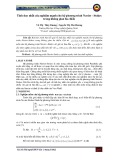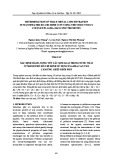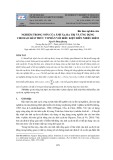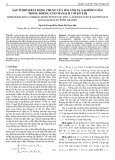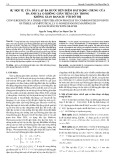
TNU Journal of Science and Technology
229(10): 42 - 50
http://jst.tnu.edu.vn 42 Email: jst@tnu.edu.vn
EFFECT OF PRESSURE ON THE PROPERTIES OF TI POROUS MATERIALS
FABRICATED BY SPARK PLASMA SINTERING METHOD
Pham Van Hao1,2, Nguyen Thi Hoang Oanh1, Vu Thi Ngoc Minh3,
Nguyen Thi Nguyet4, Pham Hung Vuong1,5, Dang Quoc Khanh1,5*
1 School of Materials Science and Engineering - Hanoi University of Science and Technology (HUST)
2Hanoi Pedagogical University 2
3School of Chemistry and Life Science - Hanoi University of Science and Technology (HUST)
4Hung Yen University of Technology and Education
5Laboratory of Biomedical Materials, Hanoi University of Science and Technology (HUST)
ARTICLE INFO
ABSTRACT
Received:
26/02/2024
Porous titanium is one of the leading biomedical materials with high
biocompatibility, durability, high stability, and non-toxic to the human
body. In this article, we study the effect of pressure on the structure and
surface morphology, pore size distribution and porosity and compressive
strength of the sample. Sample analyzes used including XRD, EDX,
determination of porosity and compressive strength. Samples are sintered
at 625 oC with pressure from 20 to 50 MPa. The results showed that the
porosity of the samples gradually increases when the pressure increases
from 20 - 40 MPa. However, as the pressure continues to increase, the
porosity of the sample decreases and the compressive strength increases
significantly. Samples at 625 oC with 40 MPa pressure reached the
highest porosity of 61.5%, pore size concentrated in the range of 200 -
350 µm and compressive strength completely suitable for them to be
able to apply this material in the field of biomedicine with suitable pore
size for the development of bone cells.
Revised:
29/5/2024
Published:
29/5/2024
KEYWORDS
Porous titanium
SPS
Pressure
Porosity
Compressive strength
ẢNH HƢỞNG ÁP LỰC ÉP ĐẾN CƠ TÍNH CỦA VẬT LIỆU TITAN XỐP
ĐƢỢC CHẾ TẠO BẰNG PHƢƠNG PHÁP THIÊU KẾT XUNG ĐIỆN PLASMA
Phạm Văn Hào1,2, Nguyễn Thị Hoàng Oanh1, Vũ Thị Ngọc Minh3,
Nguyễn Thị Nguyệt4, Phạm Hùng Vƣợng1,5, Đặng Quốc Khánh1,5*
1 Trường Vật liệu - Đại học Bách khoa Hà Nội, 2 Trường Đại học Sư phạm Hà Nội 2,
3Trường Hóa và Khoa học sự sống - Đại học Bách khoa Hà Nội, 4Trường Đại học Sư phạm Kỹ thuật Hưng Yên
5Phòng Thí nghiệm Vật liệu y sinh, Trường Vật liệu - Đại học Bách khoa Hà Nội
THÔNG TIN BÀI BÁO
TÓM TẮT
Ngày nhận bài:
26/02/2024
Titan xốp đang là một trong những vật liệu y sinh hàng đầu với tính
tương thích sinh học cao, bền và độ ổn định cao, không gây độc với cơ
thể người. Trong bài báo này, chúng tôi nghiên cứu ảnh hưởng áp lực ép
đến cấu trúc và hình thái bề mặt, sự phân bố kích thước các lỗ xốp và độ
xốp, độ bền nén của mẫu. Các phép phân tích mẫu được sử dụng như:
XRD, EDX, xác định độ xốp và độ bền nén. Các mẫu thiêu kết ở cùng
625 oC với áp lực ép từ 20 đến 50 MPa. Kết quả cho thấy độ xốp của các
mẫu tăng dần khi lực ép tăng từ 20 - 40 MPa. Tuy nhiên khi áp lực ép
tiếp tục tăng thì độ xốp của mẫu lại giảm và độ bền nén tăng lên đáng kể.
Mẫu ở 625 oC với lực ép 40 MPa đạt độ xốp cao nhất là 61,5%, kích
thước lỗ xốp tập trung trong giải 200 - 350 µm và độ bền nén hoàn toàn
phù hợp để có thể ứng dụng vật liệu này trong lĩnh vực y sinh với kích
thước lỗ xốp phù hợp cho sự phát triển các tế bào xương.
Ngày hoàn thiện:
29/5/2024
Ngày đăng:
29/5/2024
TỪ KHÓA
Titan xốp
Thiêu kết xung plasma
Áp lực ép
Độ xốp
Độ bền nén
DOI: https://doi.org/10.34238/tnu-jst.9789
* Corresponding author. Email: khanh.dangquoc@hust.edu.vn

TNU Journal of Science and Technology
229(10): 42 - 50
http://jst.tnu.edu.vn 43 Email: jst@tnu.edu.vn
1. Giới thiệu
Hiện nay, vật liệu kim loại tương thích sinh học đang được sử dụng rộng rãi trong ngành phẫu
thuật chỉnh hình. Các vật liệu này có tính tương thích sinh học và sự tương đồng về tính chất vật
lý với mô tự nhiên. Nhu cầu về các vật liệu cấy ghép hiệu suất cao nhằm giải quyết những vấn đề
về tim mạch, chấn thương, chỉnh hình, cột sống và nha khoa đã tăng lên đáng kể. Thị trường vật
liệu cấy ghép sinh học trên toàn thế giới đạt khoảng 94,1 tỷ USD vào năm 2012 và tăng lên
khoảng 134,3 tỷ USD vào năm 2017 [1]. Nhằm phục vụ cho nhu cầu xã hội, các nhà khoa học
đang tập trung nghiên cứu để tạo ra các loại vật liệu y sinh mới có tính năng tốt. Trong kỹ thuật
chỉnh hình, các mô cấy ghép thường được chế tạo bằng vật liệu kim loại hoặc hợp kim do có độ
cứng và độ bền cơ học cao hơn so với vật liệu hữu cơ. Các loại kim loại phổ biến được sử dụng
trong kỹ thuật chỉnh hình bao gồm kim loại vĩnh cửu (hợp kim của titan, thép không gỉ, hợp kim
crom-coban…) và kim loại phân hủy sinh học (trên cơ sở hợp kim của ma-giê). Các mô cấy ghép
sử dụng trong khớp gối, khớp cổ tay, xương đùi… thường được làm bằng các vật liệu kim loại
vĩnh cửu [2]. Trong khi đó, các vật liệu có khả năng phân hủy sinh học thường được sử dụng cho
các mô cấy ghép tạm thời và các phụ kiện sử dụng trong một khoảng thời gian nhất định [3].
Trong số những vật liệu mô cấy ghép, vật liệu titan xốp có nhiều ưu điểm nhất vì không chỉ có
khả năng chống ăn mòn, mài mòn và tính chất cơ học tốt, mà mô đun đàn hồi và tỷ trọng của nó
còn gần giống với xương người, tính tương thích sinh học cao, ổn định trong môi trường sinh lý
của vật chất... [2], [4], [5].
Bên cạnh đó, vật liệu titan xốp chứa các lỗ xốp với các kích thước cỡ micro cho sự phát triển
của mô xương, sự phân bố của các mạch máu, đường vận chuyển chất dinh dưỡng, chất thải.
Ngoài ra, sự tồn tại của các lỗ xốp kín hoặc hở trong titan xốp không những giữ được độ bền cao,
biến dạng dẻo lớn mà còn tạo ra mô đun đàn hồi thấp để tránh tạo ra chênh lệch ứng suất giữa
xương tự nhiên và mô cấy ghép.
Trong các phương pháp chế tạo titan xốp ngày nay, kỹ thuật thường được sử dụng là luyện
kim bột [6] - [8]. So với các phương pháp luyện kim bột thông thường để chế tạo các kim loại có
mật độ cao như ép nóng, thiêu kết xung điện plasma (SPS) được biết đến như một phương pháp
hiện đại giúp nhanh chóng tạo ra sản phẩm ở nhiệt độ thấp hơn. Đồng thời SPS có những ưu
điểm vượt trội như thời gian thiêu kết ngắn, tốc độ nâng nhiệt nhanh là một phương pháp hiệu
quả để nghiên cứu và sử dụng chế tạo vật liệu xốp hiện nay [9], [10]. Việc sử dụng quy trình
thiêu kết trong thời gian ngắn rất hữu ích khi có yêu cầu cao về cấu trúc vi mô hạt mịn và độ xốp
đồng đều. Trong quy trình SPS, một dòng điện xung được đưa vào trong khi tải bên ngoài được
ghép nối, sau khi đặt bột vào khuôn graphite. Sau đó, hiện tượng chuyển giao và khuếch tán vật
chất được tăng tốc do tạo ra plasma giữa các hạt ban đầu dẫn đến sự phân hủy và làm sạch các
tạp chất oxit khỏi các lớp bề mặt. Hơn nữa, hiệu ứng Jun và biến dạng dẻo được hỗ trợ bởi áp
suất dẫn đến khả năng cô đặc và thiêu kết tốt hơn [11], [12].
Ngoài yêu cầu cao về chất lượng của titan xốp thì thiêu kết cũng là một công đoạn vô cùng
quan trọng. Thiêu kết là công đoạn cuối cùng của việc chế tạo titan xốp, ảnh hưởng của các thông
số công nghệ như nhiệt độ thiêu kết, tốc độ nâng nhiệt, áp lực ép và thời gian thiêu kết là rất lớn.
Mẫu thu được cần phải đạt độ xốp, cấu trúc và kích thước lỗ xốp phù hợp để các mô xương bám
vào và phát triển.
Mỗi năm, nước ta phải nhập ngoại hàng trăm nghìn chi tiết cấy ghép các loại như: nẹp xương,
răng giả, khớp giả, đinh vít, van tim, stent thông mạch máu, thậm chí làm vỏ não với giá thành
cao và không chủ động được. Để phục vụ nhu cầu nội địa hóa, phát triển sản phẩm và giảm giá
thành, nhóm chúng tôi đã lựa chọn nghiên cứu ảnh hưởng áp lực ép đến tính chất vật liệu Titan
xốp chế tạo bằng phương pháp thiêu kết xung điện plasma.

TNU Journal of Science and Technology
229(10): 42 - 50
http://jst.tnu.edu.vn 44 Email: jst@tnu.edu.vn
2. Phƣơng pháp nghiên cứu
2.1. Chế tạo vật liệu xốp
Vật liệu Titan xốp được chế tạo bằng phương pháp luyện kim bột, quy trình chế tạo được mô
tả trong Hình 1. Trong đó bột Titan có kích thước trung bình nhỏ hơn và đạt độ tinh khiết
lớn hơn 99,95% (Fisher Scientific, Phần Lan), muối NaCl có độ sạch trên 99,5% (Macklin, Trung
Quốc) với các hạt muối dạng lập phương nằm trong khoảng 200 - 250 m.
Hình 1. Quy trình chế tạo vật liệu titan xốp
Hỗn hợp bột Titan và NaCl (tỷ lệ Ti:NaCl tương ứng là 40:60% về khối lượng, được viết tắt là
Ti46) được phối trộn bằng máy nghiền tang trống ngang trong môi trường có khí Ar bảo vệ, với
các thông số được trình bày trong Bảng 1. Mục đích của phần công việc này nhằm trộn đồng đều
bột Ti và NaCl, tăng diện tích tiếp xúc giữa chúng, để các lỗ xốp sau quá trình xử lý được đồng
đều thuận lợi cho khả năng phát triển tế bào sau này.
Bảng 1. Các thông số phối trộn mẫu Ti46
Tỷ lệ bi:bột
3:1
Tốc độ vòng quay
50 vòng/ph
Thời gian trộn
5 h
Môi trường bảo vệ
Khí Argon
Hình 2. Sơ đồ thực nghiệm quá trình thiêu kết
Các mẫu bột hỗn hợp Ti46 sau khi phối trộn được đưa vào SPS bằng thiết bị LABOX - 625F
(Sinterland, Nhật Bản, dự án SAHEP, Đại học Bách khoa Hà Nội). Trong đó, khuôn ép graphite
hình trụ có đường kính trong 10 mm, hỗn hợp bột Ti46 được thiêu kết ở cùng một nhiệt độ 625 oC,
tốc độ nâng nhiệt 100o/phút, giữ nhiệt trong 10 phút, áp lực ép lần lượt thay đổi là 20, 30, 40 và 50
Mpa. Các mẫu thiêu kết được tiến hành trong môi trường chân không (áp suất < 5 Pa); dòng 1 chiều
có điện áp < 5 V, cường độ dòng điện trong khoảng 1000 - 2000 A. Sau thiêu kết, các mẫu được
khuấy từ bằng nước khử ion tại 80 oC trong thời gian 6 - 8 h nhằm loại bỏ hoàn toàn muối NaCl
trong mẫu thiêu kết. Sơ đồ thực nghiệm quá trình SPS được biểu diễn trong Hình 2.

TNU Journal of Science and Technology
229(10): 42 - 50
http://jst.tnu.edu.vn 45 Email: jst@tnu.edu.vn
2.2. Các phép phân tích
Cấu trúc pha, định hướng tinh thể và độ kết tinh của mẫu Ti46 được nghiên cứu trên máy
nhiễu xạ tia X (XRD) của hãng PANalytical AERIS, Hà Lan (dự án SAHEP, Đại học Bách khoa
Hà Nội). Đặc tính hình thái học bề mặt, cấu trúc xốp, hình dạng và kích thước lỗ xốp; phân tích
thành phần nguyên tố bằng phổ tán xạ năng lượng tia X (EDX) được thực hiện bằng kính hiển vi
điện tử quét (SEM), (JSM-200, JEOL, Nhật Bản, dự án SAHEP, Đại học Bách khoa Hà Nội) và
kính hiển vi 3D kỹ thuật số VHX-7000, KEYENCE, Nhật Bản (dự án SAHEP, Đại học Bách
khoa Hà Nội). Độ xốp của mẫu được xác định tại Trung tâm kiểm định Vật liệu xây dựng
(VILAS 003) bằng phương pháp cân thủy tĩnh.
Các mẫu Ti46 đường kính 10 mm, chiều cao 12 mm được khảo sát độ bền nén bằng máy đo
MTS, Mỹ (dự án SAHEP, Đại học Bách khoa Hà Nội).
Độ bền nén được xác định theo công thức:
(MPa) (1)
P: tải trọng đặt lên mẫu (N)
S: diện tích bề mặt (mm2)
3. Kết quả thảo luận
3.1. Đặc trưng cấu trúc vật liệu titan xốp
Hình 3a là phổ nhiễu xạ tia X của các mẫu Ti46 được chế tạo bằng phương pháp SPS ở 625oC
với các áp lực ép khác nhau. Tất cả các mẫu đều có các đỉnh nhiễu xạ tại các vị trí góc :
35,093º; 38,421º; 40,17º; 53,004º; 62,949º; 70,66º; 76,218º và 77,368º. So sánh vị trí các đỉnh
nhiễu xạ này hoàn toàn trùng hợp với phổ XRD của thẻ PDF#44-129. Tương ứng vị trí các đỉnh
nhiễu xạ trên là định hướng của các mặt phẳng mạng tinh thể (100), (002), (101), (102), (110),
(103), (112) và (201) được biểu diễn trong Hình 3a. Điều này cho thấy pha tinh thể duy nhất
trong mẫu chế tạo được là pha -Ti. Đồng thời các đỉnh nhiễu xạ có hình dạng khá sắc nét, có thể
chỉ ra rằng các mẫu có độ kết tinh cao [13]. Trong các mẫu không thấy xuất hiện pha -Ti khi
nhiệt độ thiêu kết dưới 882 oC, các kết quả này là hoàn toàn phù hợp với những nghiên cứu trước
đây [10], [14] - [16].
Hình 3. Phổ XRD của mẫu Ti46 chế tạo bằng phương pháp SPS ở nhiệt độ 625oC
với các áp lực ép 20, 30, 40 và 50 MPa
Phổ XRD của các mẫu Ti46 được chế tạo bằng phương pháp SPS ở nhiệt độ thiêu kết 625 oC
với các áp lực ép khác nhau từ 20 đến 50 MPa được biểu diễn trong Hình 3a cho thấy mẫu không
có pha tạp, chỉ có pha tinh thể -Ti và do đó, không có sự biến đổi pha rõ ràng nào xảy ra trong
quá trình thiêu kết với các lực ép khác nhau. Trong Hình 3b, biểu diễn phổ XRD của các mẫu
trong không gian 3D, các đỉnh nhiễu xạ không thay đổi vị trí (góc ), tuy nhiên, cường độ của

TNU Journal of Science and Technology
229(10): 42 - 50
http://jst.tnu.edu.vn 46 Email: jst@tnu.edu.vn
chúng tăng dần khi áp lực ép thiêu kết tăng từ 20 MPa, đạt giá trị lớn nhất ở 40 MPa sau đó giảm
dần khi áp lực ép thiêu kết ở 50 MPa. Đặc điểm này cho thấy mẫu thiêu kết ở áp lực ép 40 MPa
có độ kết tinh cao nhất. Thông thường nhiệt độ giữa bề mặt khuôn và thực tế bên trong mẫu luôn
có sự chênh lệch nhất định trong quá trình thiêu kết. Độ dốc nhiệt độ xuyên tâm trong các mẫu
dẫn điện là khoảng 79 oC tương ứng cho đường kính mẫu 20 mm [17], đồng thời việc kiểm soát
nhiệt độ thiêu kết do sự chênh lệch nhiệt độ giữa tâm mẫu và nhiệt kế được khống chế ở mức
dưới 5 oC [16], [18]. Bột Titan là vật liệu dẫn điện với đường kính mẫu 10 mm, nhiệt độ thiêu kết
là 625 oC, cộng với nhiệt độ chênh lệch kiểm soát 5oC và gradient nhiệt độ nhỏ hơn 79 oC vẫn
thấp hơn nhiệt độ nóng chảy của NaCl (802 oC). Như vậy trong quá trình thiêu kết, khi áp lực ép
thấp, muối NaCl chưa nóng chảy và không có bất cứ phản ứng kết hợp nào giữa Ti với oxy và
làm phân ly Cl trong NaCl. Khi tăng dần áp lực ép thiêu kết, giúp cho việc kết tinh Ti được diễn
ra tốt hơn. Tuy nhiên, khi lực ép đủ lớn, cùng với tốc độ nâng nhiệt là 100 oC/phút, ở vị trí cổ
khuôn có thể dẫn đến việc các hạt Ti bị quá mức do điện trở tiếp xúc cục bộ cao, cao hơn nhiệt độ
nóng chảy của NaCl. Vì thế, tại vị trí này, NaCl có thể bị nóng chảy cục bộ, làm ảnh hưởng trực
tiếp đến quá trình kết tinh của Ti. Như vậy, với áp lực ép thiêu kết 40 MPa ở nhiệt độ 625 oC,
mẫu có độ kết tinh cao nhất.
3.2. Đặc trưng hình thái bề mặt
Hình 4 là ảnh hiển vi kỹ thuật số của bề mặt các mẫu thiêu kết Ti46 ở cùng nhiệt độ 625 oC với
các áp lực ép khác nhau 20 MPa (Hình 4a), 30 MPa (Hình 4b), 40 MPa (Hình 4c) và 50 MPa (Hình
4d). Tất cả các ảnh trong Hình 3 có cùng độ phóng đại được biểu diễn với thang đo 250 m. Nhận
thấy các mẫu sau khi xử lý loại bỏ muối NaCl đều có cấu trúc xốp, các lỗ xốp được phân bố đều
trong khối vật liệu, kích thước của chúng tăng dần ở các mẫu khi áp lực ép thiêu kết tăng.
Hình 4. Ảnh hiển vi kỹ thuật số của bề mặt mẫu Ti46 thiêu kết ở cùng nhiệt độ 625 oC
với các áp lực ép khác nhau: a) 20 MPa, b) 30 MPa, c) 40 MPa và d) 50 MPa
Hình thái bề mặt của các mẫu được xử lý trực tiếp trên thiết bị hiển vi 3D kỹ thuật số. Việc
xác định kích thước các lỗ xốp (bao gồm cả chiều sâu của các lỗ xốp) trên bề mặt mẫu, được biểu
diễn trong Hình 5a. Thành phần các chất trong mẫu thiêu kết sau xử lý được phân tích bằng phổ



![Trạng thái plasma Quark-Gluon là gì? [Mới nhất 2024]](https://cdn.tailieu.vn/images/document/thumbnail/2025/20250411/vimaito/135x160/411744365164.jpg)


